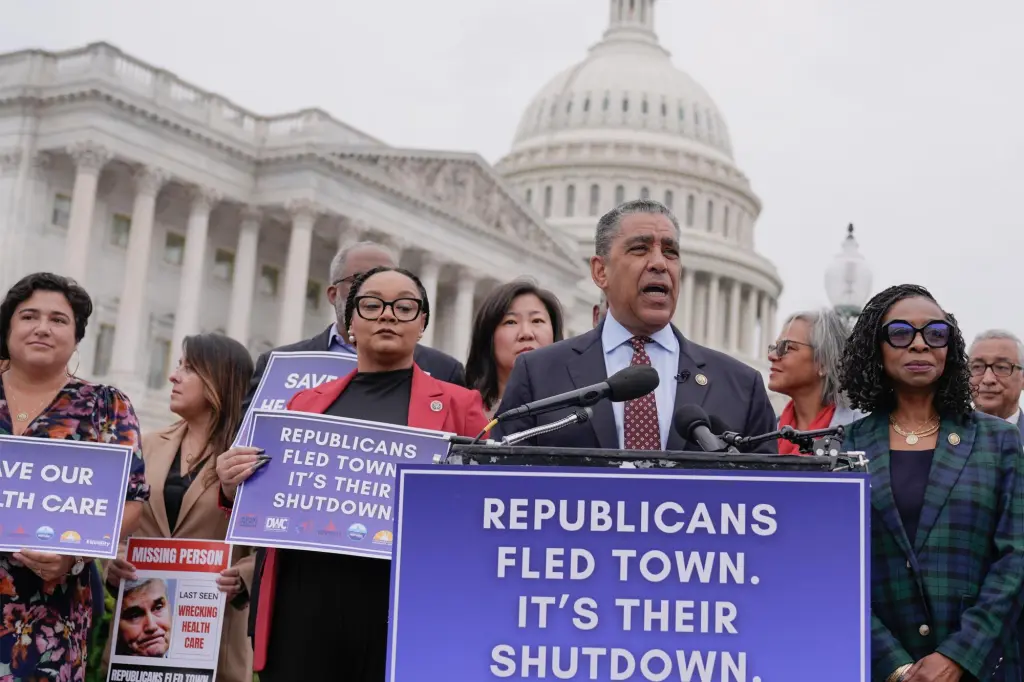Japan’s ruling party is in crisis as voters swing to right-wing rivals. Can a new leader save it?

By Jessie Yeung, Hanako Montgomery, CNN
Tokyo (CNN) — Japan’s ruling party is in trouble, and it knows it.
The country is rife with political instability, having cycled through four prime ministers in the last five years – all members of the Liberal Democratic Party (LDP).
And while the LDP has ruled Japan almost continuously for the last 30 years, it’s now in a precarious position as it prepares to vote for a new party leader on Saturday – mired in scandal, widely unpopular, and abandoned by longtime supporters who have instead flocked to new right-wing parties.
The next party leader could very well become the country’s next prime minister, but even that’s not guaranteed; voters delivered a clear rebuke in the past two parliamentary elections, delivering seats to opposition parties and stripping the LDP of its majority.
Key Japanese neighbors, especially China, will be watching closely to see who comes out on top.
Japan’s political volatility began after Shinzo Abe stepped down as prime minister in 2020. Abe – widely seen as Japan’s last stable leader, having ruled for nearly nine years – was assassinated in 2022.
Since his tenure ended, the LDP has faced fallout over a slush fund scandal, an inflation surge, and a rightward political shift across the country.
This election, the LDP hopes, might change that. The front-runners all offer a different way forward. One is a veteran operator and government bureaucrat. Another, who could be Japan’s youngest postwar prime minister, bills himself as a moderate reformist. The third is a firebrand conservative who could become the country’s first female leader.
“They are looking to try to change the face of the party, to get back voters that they’ve lost in the last two elections,” said Jeffrey Hall, a Japanese studies lecturer specializing in politics at Kanda University of International Studies in Chiba.
“In the past, voters often overlooked scandals, but now I think they’re very fed up with it. And the alternatives offered by other conservative parties, center-right or far-right parties have been more attractive to voters,” he added.
This frustration is clear among the public, with few expressing any optimism or excitement for the election when CNN spoke to them on the street earlier this week. Most declined to share their names, but one salaryman described the LDP as lacking transparency and accountability, while a 60-year-old professional in Tokyo’s Ginza district called all the candidates “weak-kneed.”
One finance worker in Tokyo’s Roppongi district was scathing.
“Even watching the current LDP leadership election, in the end, nothing fundamental ever changes, and they don’t say anything meaningful,” he said.
“It makes you wonder, ‘Are there any decent people left?’ This guy, that guy… they’re all the same.”
How we got here
One of the biggest drivers of the LDP’s downfall was a funding scandal in late 2023 involving millions of dollars in undocumented political funds, and lawmakers allegedly lining their own pockets with kickbacks, or failing to properly declare their income.
Despite some efforts at damage control, the party “hasn’t really done anything significant to change its ways, it hasn’t significantly punished politicians who were involved in these scandals,” causing voters to lose trust in the LDP, said Hall.
Public sentiment was already souring as inflation and living costs skyrocketed. For instance, the cost of rice – Japan’s prime staple food – has almost doubled from last year, staying stubbornly high even after authorities released emergency reserves and imported foreign rice.
Voters also tend to lean more nationalist and conservative during economic downturns, said Hajime Kidera, a professor at Meiji University’s School of Political Science and Economics – which is one reason Abe was so popular during the post-recession early 2010s. “He effectively tapped into those frustrations; in other words, the feelings of people who took pride in being Japanese but were struggling in their daily lives,” Kidera said.
“The same is said about Germany, the UK, and other advanced countries,” he added. And it could be why many in Japan are now gravitating toward more conservative, Abe-like candidates.
Another issue grabbing national attention is rising numbers of foreign residents and visitors, which has fueled widespread anti-foreigner sentiment that sometimes turns outright xenophobic. Many argue that Japan is at risk of losing its way of life, or that Japanese workers are being edged out of jobs.
“It has become a very much important issue in the Japanese landscape,” said Hiroshi Shiratori, a professor of political science at Hosei University. “You had the populist new right movement in Europe and the United States; the same thing (is occurring) in Japan gradually.”
Some young far-right parties have capitalized on this shift. For instance, the burgeoning right-wing populist party Sanseito won big in parliamentary elections in July, bagging 14 seats in the upper house after campaigning on the Trumpian message “Japanese First.”
Sanseito began as an online group, whose YouTube channel now has more than half a million subscribers. Its success also reflects Japan’s shift to become a “digitalized society” in recent years, said Shiratori – with the LDP “lagging behind” and increasingly viewed as old-fashioned and disconnected from voters.
The LDP is now under intense pressure to win back right-wing voters. In ongoing campaigns, most candidates promise to tighten immigration – while taking pains not to alienate moderate parts of the base.
“The party is entering an identity crisis, in which it has failed to cater to both the general public and conservative voters,” said Rintaro Nishimura, a Tokyo-based senior associate at The Asia Group, a consulting firm.
“Now, it looks as though the LDP is only focused on self-preservation and with no sense of direction,” Nishimura added.
The front-runners
Though a number of candidates are in the running, attention has largely been focused on three front-runners – who could all take Japan in a different direction.
The most popular among the public so far, according to several polls, is former economic security minister Sanae Takaichi. If she wins this weekend and is nominated for prime minister, she could be the country’s first-ever female leader in a country where men historically dominate politics as much as they do the boardroom.
But she’s the most deeply conservative of the bunch – which could alarm some in the party, as well as some of Japan’s key neighbors, especially China and South Korea. She’s hawkish on security and diplomacy, conservative on social issues, and keen on boosting government spending to stimulate economic growth (in a continuation of former leader Abe’s policies).
While Takaichi has compared herself to Margaret Thatcher, the first woman to become British prime minister, some skeptics view her as “more like a Liz Truss in that she could damage the economy,” said Hall.
If she wins, it could signal “an attempt to return to the Abe era of conservativism” and to win back right-wing voters, said Nishimura. It could also complicate relations with South Korea, added Hall – like Abe, Takaichi regularly visits a controversial war shrine that includes the names of convicted war criminals, viewed by Asian neighbors as a symbol of Japan’s imperial militarism of the early 20th century.
Within the LDP, there may be greater support for agriculture minister Shinjiro Koizumi – who, at 44, could become Japan’s youngest prime minister since the end of WWII. He’s the son of former Prime Minister Koizumi Junichirō, and the fourth generation of a political dynasty.
He is seen as a younger, more moderate voice – having vowed to clean up politics, initiate discussions on constitutional reform and allow married couples to use separate surnames, something currently banned under law. (Takaichi has vehemently opposed changing the law.)
Koizumi is also friendly with the center-right Japan Innovation Party, also known as Ishin, which holds a significant number of seats in parliament, said Hall – so if he wins, the LDP may gain a valuable partner in passing legislation and winning elections.
“A Koizumi victory would suggest that the LDP believes he represents the ‘rebirth’ of the party and is most capable of winning younger generations of voters in the elections to come,” said Nishimura.
Finally, there’s Chief Cabinet Secretary Yoshimasa Hayashi, whose current role is pivotal as top government spokesperson. He’s among the most experienced, having served in various ministerial roles including defense, foreign affairs and agriculture – gaining him a reputation as “the ‘handyman’ who is called upon in times of crisis,” said Nishimura.
While he’s not as colorful a character as the other two candidates, he’s seen as a steady presence that could bring much-needed stability to the party. And he might have an advantage working with international partners, as a Harvard-educated fluent English speaker who once served as a staffer for a US representative and a US senator.
The path forward
But whoever wins, securing the party leadership is just the first step – and a host of problems await.
Since the LDP has now lost majority control of parliament, there is no guarantee that its nominee will be selected as prime minister. It still has a good shot at it, since opposition parties are currently divided and unable to form a unified front, experts say – but it’s no longer a sure thing, as it was in years past.
“There is great talk about enlarging the coalition government – they might put another opposition party into that LDP-Komeito coalition” to regain a parliamentary majority, said Shiratori. “So one of the issues is, who can make a good relationship with one of the opposition parties?”
Whichever candidate is elected will also likely face opposition and infighting from within their own party, given the split between LDP conservatives and moderates, said Hall.
Then comes the real work of actually governing the world’s fourth-largest economy, with the future prime minister inheriting a slate of thorny issues. Most pressing is inflation – but there’s also Japan’s demographic crisis, with a rapidly aging population, falling birthrate, shrinking workforce, and growing costs of elder care and welfare.
There’s also the matter of managing a relationship with the US administration of President Donald Trump and reasserting Japan’s presence on the world stage, diminished in the last few years thanks to the revolving door of leaders.
With so much at stake, “it doesn’t seem likely that whoever becomes prime minister can suddenly refresh the LDP and make it an inspiring party that the voters will back,” said Hall.
“It’s really hard to see Japan having stable leadership.”
The-CNN-Wire
™ & © 2025 Cable News Network, Inc., a Warner Bros. Discovery Company. All rights reserved.
CNN’s Yumi Asada and Riku Inoue contributed to this report.



